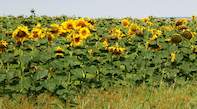Sunflowers can be produced in most parts of South Africa where the annual rainfall is between 475mm and 675mm per year. However, sustainable sunflower production needs to be profitable.

And the profitability of sunflower production is dependent on more than just the rainfall - it is determined on the relationship between the input costs, the price and the yield.
To optimise the yield, factors such as soil types, soil depth, tillage, pH, soil fertility and fertilisation, climate and rainfall, cultivar selection, plant population, weed and pest control will have to be considered.
In terms of profitability, the price received by the farmer for sunflowers will depend on the price of imported vegetable oil, imported oilcake and the exchange rate of the rand against the US dollar. South African farmers compete with imported products produced with government subsidies.
Growing Conditions for Sunflowers
Sunflowers is an annual summer crop that is sensitive to cold and frosts at various stages of development. It is, therefore, necessary to ensure that sunflowers have 120 to 140 frost-free days during the growing season.
Planting will start at the beginning of November to the end of December in the eastern areas and can extend to mid-January in the western areas.
Short dry spells of one to three weeks often limit sunflower yields, as low soil water levels can stress the sunflower plant.
Sunflowers prefer well-drained soil with good topsoil that will allow root penetration to 750mm or deeper. Sandy or clay soil is not ideal for sunflower production. Waterlogged soils may result in a yellowing of sunflowers due to denitrification.
Soil preparation is the most important, as well as the most expensive aspect of the sunflower production cycle. Tilling of the soil is aimed at optimising water filtration and minimising evaporation; keep the topsoil loose (± 5cm) in the presence of organic material.
Conservation tillage methods (such a minimum till) maintain and improve the soil and is also cost-effective. With minimum-till, crop residue is left on the land and weed control is minimal. This leftover plant stubble becomes a source of organic material for the soil microbes and further minimises water and wind erosion.
Planting of Sunflowers
According to the Department of Agriculture, Forestry and Fisheries (DAFF), planting density for sunflower ranges from 25 000 to 35 000 plants per hectare, depending on the yield potential of the area.
Row width can range from 90 to 100 cm or even 1,5 m to 2,1 m depending on the equipment used. Sunflower seeds are planted at relatively shallow depths. Planting depth ranges from 25 mm in soils with high clay content to 50 mm in sandy soils.
Due to its finely branched and extensive root systems, sunflowers utilise soil nutrients very well but may benefit from nitrogen and phosphorus fertilisation, depending on soil analysis prior to planting.
Harvesting of Sunflowers
The period from seeding to harvesting for sunflower ranges from 125 to 130 days. When the plant is reaching maturity, leaves will turn yellow and the flowerheads will change from green to yellow.
Harvesting should start as soon as 80% of the sunflower heads are brown. This will minimise losses caused by birds, lodging and shattering.
Sunflowers are harvested by machine (combine harvester) and sold to processing companies for the production of oil, biodiesel and feedstock (oilcake or as birdseed).
How to Make Sunflower Oil
After harvesting, the sunflower seeds are transported to the crushing plant. When making sunflower oil the sunflower seeds are cleaned and the hulls are removed. The cleaned seeds (‘meat’) are crushed and further ground up before the meat is heated. The meat is sent to the expeller and crushed into sunflower meal and crude oil. Solvents are used to extract the last oil from the oilseed cake. The crude sunflower oil is then refined. Refining involves removal of the bitterness, colour and odours. The most common byproduct of the sunflower seed oil process is the oilseed cake/meal. This is usually used to make animal feed and low-grade fertilizer.
By Marinda Louw